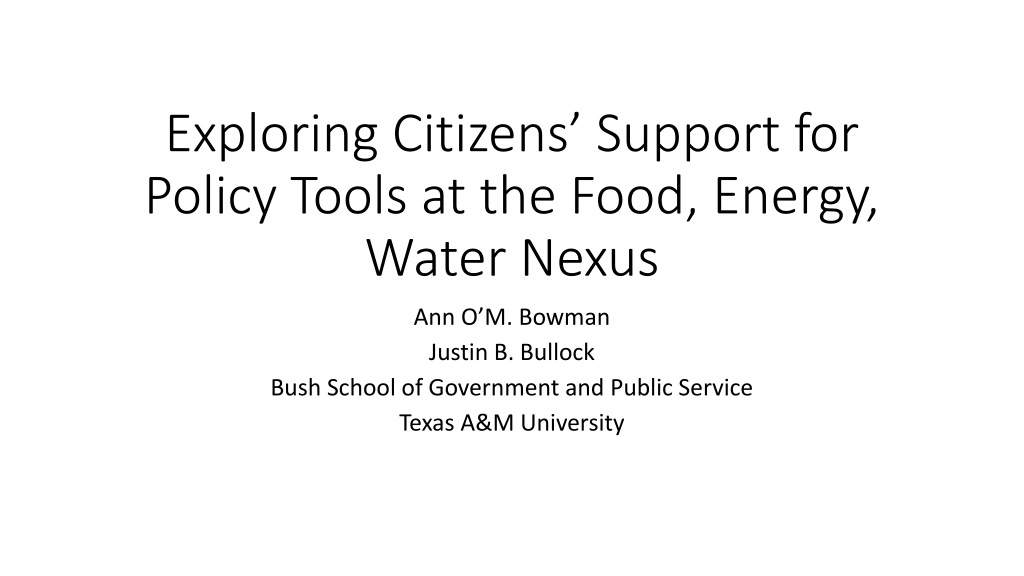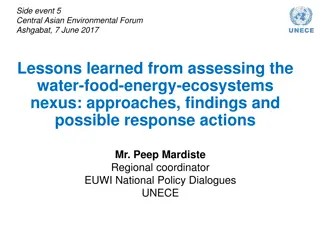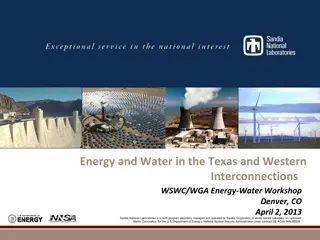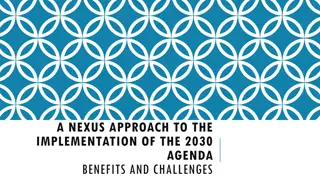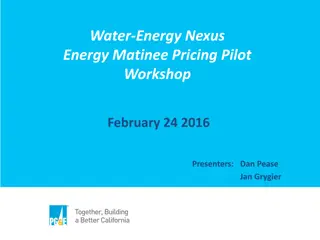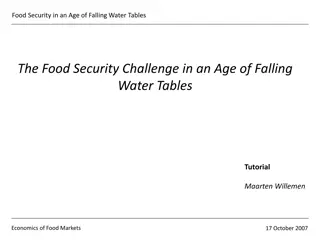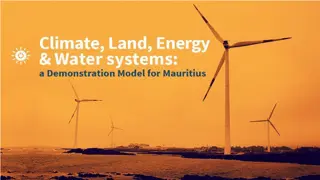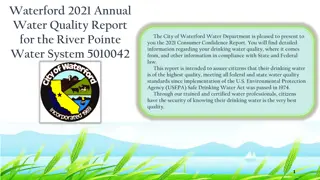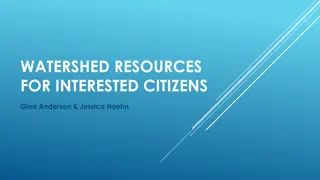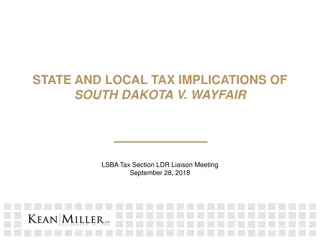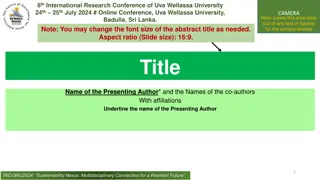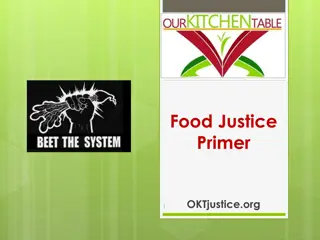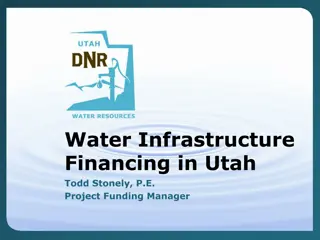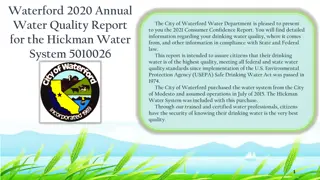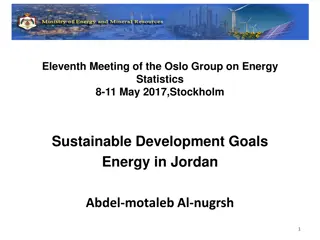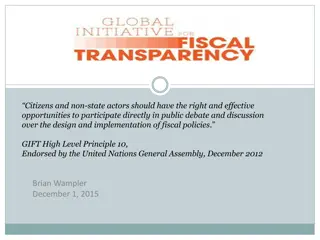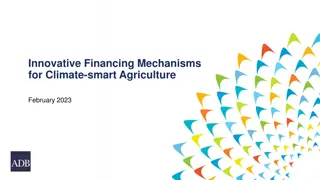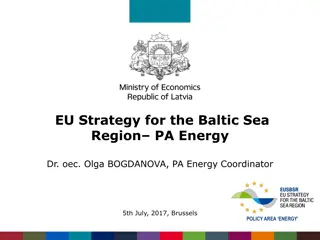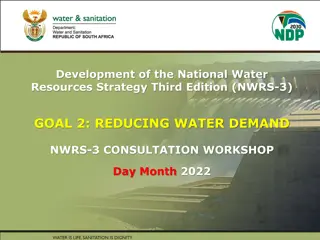Understanding Citizens' Support for Policy Tools at the Food, Energy, Water Nexus
This research delves into public opinion and policy preferences surrounding the Food, Energy, Water (FEW) Nexus, focusing on factors driving citizen support. Through data analysis and methodological approaches, the study explores diverse policy tools such as tax incentives for farmers, establishing seed banks, and promoting energy-efficient farming methods to address critical resource issues. By understanding public sentiment and preferences, policymakers can design effective tools for sustainable outcomes in the FEW Nexus.
Download Presentation

Please find below an Image/Link to download the presentation.
The content on the website is provided AS IS for your information and personal use only. It may not be sold, licensed, or shared on other websites without obtaining consent from the author. Download presentation by click this link. If you encounter any issues during the download, it is possible that the publisher has removed the file from their server.
E N D
Presentation Transcript
Exploring Citizens Support for Policy Tools at the Food, Energy, Water Nexus Ann O M. Bowman Justin B. Bullock Bush School of Government and Public Service Texas A&M University
Overview Introduction FEW Nexus Public Opinion and Policy Preferences Data and Methods Descriptive Analysis Multivariate Analysis Conclusion
Introduction Food, Energy, Water Nexus has generated much attention in several fields Efforts to devise technical solutions to FEW resource issues One important missing piece: Public policies Important first pieces in filling this gap: What do citizens support? What factors drive that support?
FEW Nexus Research moved from silos to dyads (Mohtar & Lawford 2016; Ingram et al. 1984) Three-way interaction, or nexus research in scholarly circles begins in 2008 (Hellergers et. al. 2008) food energy water In the long run, treating food, energy, water issues as a nexus increases the likelihood that public policies will lead to more efficient and equitable outcomes (Mohtar and Lawford 2016)
Public Opinion and Policy Preferences Public opinion has an impact on policy formulation (Page and Shapiro 1983; Stimson, Mackuen, and Erikson 1995) However, identifying the factors that drive public opinion has been inconclusive Gilens (2001) shows political knowledge (general and specific) influences public opinion. How might policymakers design policy tools to maximize political support? Are these preferences for certain types of policy tools consistent across FEW nexus nodes?
Data and Methods GfK Group public opinion survey Survey items developed in an iterative process Total sample without oversampling is 1,463 Broadly representative of standard demographic characteristics of the population Descriptive analysis Multivariate analysis Factor analysis Factor score regression analysis
Descriptive Analysis % Tool Type Food Policy Options Support Provide space free of charge for community gardens Build composting facilities for food waste Provide space free of charge for local farmers markets Establish seed banks to maintain biodiversity of critical food crops Give tax incentives for farmers to reduce use of fertilizers & pesticides Give tax incentives for farmers to use more energy efficient methods of growing & transporting food Require that farmers use soil conservation measures Limit amount of land that can be used to grow crops for biofuels rather than food Charge significant impact fees to housing developers to help prevent the loss of agricultural land Charge higher licensing fees to restaurants that do not follow an approved plan to reduce food waste Conduct campaigns to encourage buying locally grown foods Develop a comprehensive national plan for preserving our agricultural lands Spending 1 61 Spending 2 59 Spending 3 60 Spending 4 52 Tax Incentives 1 59 Tax Incentives 2 64 Regulate 1 56 Regulate 2 40 Fees 1 41 Fees 2 44 Promote 60 Plan 58
Tool Type Spending 1 ? Descriptive Analysis % Support Energy Policy Options Build additional power plants Build pipelines to bring oil from other regions Build charging stations for electric vehicles at government owned or funded facilities Increase federal funding for research on renewable energy technologies Give tax incentives to energy companies to develop more solar energy technologies Give tax cuts to energy companies to increase oil & gas exploration in the U.S. Relax environmental standards for energy industries* Require that new construction meets high energy efficiency standards Charge higher energy rates during high demand times of day Charge higher energy rates for high volume users Conduct campaigns for voluntary energy conservation Develop a comprehensive national plan for allocating energy across state borders 37 Spending 2 42 Spending 3 46 Spending 4 53 Tax Incentives 1 61 Tax Incentives 2 35 Regulate 1 48 Regulate 2 65 Fees 1 25 Fees 2 45 Promote 54 Plan 43
Descriptive Analysis ? Tool Type Spending 1 % Support Water Policy Options Build dams & reservoirs Build pipelines to bring water from other regions Build desalination plants to make sea water drinkable Buy water from farmers to use in cities Give tax incentives for the installation of water-saving equipment Give tax incentives for implementing efficient irrigation systems for agriculture Require low water use landscaping Require that lawn watering use reclaimed/reused water instead of drinking water Charge higher water rates during the hottest part of the summer Charge higher water rates for high volume users Conduct campaigns for voluntary water conservation Develop a comprehensive national plan for allocating water across state borders 45 Spending 2 35 Spending 3 54 Spending 4 19 Tax Incentives 1 64 Tax Incentives 2 62 Regulate 1 51 Regulate 2 55 Fees 1 18 Fees 2 50 Promote 51 Plan 43
Multivariate Analysis Table 2: Factor Analysis Food Policy Factor Factor Eigenvalue Difference Proportion Cumulative Factor1 5.81856 5.52585 Factor2 0.29272 0.11568 Factor3 0.17704 0.09562 Factor4 0.08142 0.01852 Factor5 0.06289 0.06433 Variable Factor1 Factor2 Item 1 0.7233 -0.2867 Item 2 0.7361 -0.0165 Item 3 0.7538 -0.0491 Item 4 0.7308 0.048 Item 5 0.7307 0.1105 Item 6 0.7196 0.1674 Item 7 0.4502 0.0938 Item 8 0.7761 0.0352 Item 9 0.7233 -0.3144 Item 10 0.6935 -0.0429 Item 11 0.6052 0.1581 Item 12 0.6513 0.1721 Table 3: Factor Analysis for Energy Policy Factor Factor Eigenvalue Difference Proportion Cumulative Factor1 3.3925 1.7904 Factor2 1.60211 1.11733 Factor3 0.48478 0.34531 Factor4 0.13947 0.1358 Factor5 0.00367 0.05716 Variable Factor1 Factor2 Item 1 0.1263 0.5371 Item 2 -0.0572 0.7183 Item 3 0.6352 0.1036 Item 4 0.7135 0.0434 Item 5 0.6015 0.1692 Item 6 0.334 -0.5601 Item 7 0.7356 -0.0078 Item 8 0.0226 0.658 Item 9 0.6854 -0.0211 Item 10 0.754 -0.0752 Item 11 0.3675 0.0601 Item 12 0.5219 0.0033 0.7296 0.3446 0.1043 0.03 0.0008 0.7296 1.0742 1.1784 1.2084 1.2092 1.0058 0.0506 0.0306 0.0141 0.0109 1.0058 1.0564 1.087 1.1011 1.1119 Factor3 0.0062 -0.0477 0.0084 -0.2093 -0.017 -0.1057 -0.1026 -0.0844 -0.0977 -0.0787 0.4696 0.4162 Factor4 Factor5 -0.0093 -0.0063 0.0118 0.0331 -0.0399 -0.0001 -0.0086 0.0198 -0.0122 0.003 0.0065 0.0064 Uniqueness Factor3 Factor4 -0.0396 0.1028 0.0421 0.0089 -0.0821 0.0537 0.0981 -0.0074 -0.0795 0.1334 -0.1118 -0.1073 Factor5 0.0139 -0.0397 -0.0679 0.0965 -0.0878 -0.0534 0.1528 0.0258 0.0278 -0.0418 0.0883 -0.0479 Uniqueness 0.3847 0.4439 0.4227 0.4029 0.4392 0.4448 0.7337 0.3305 0.3707 0.4972 0.5651 0.5319 0.1242 0.0715 0.1504 -0.0675 -0.077 0.1473 0.1442 -0.0603 -0.1484 -0.091 -0.0758 0.0605 0.68 0.091 0.0429 0.0165 -0.2265 0.0155 0.0604 0.1475 -0.2553 0.0162 0.0212 0.1529 0.0211 0.4734 0.563 0.4396 0.6018 0.5418 0.4274 0.5554 0.4981 0.4113 0.635 0.5507
Multivariate Analysis Table 4: Factor Analysis for Water Policy Factor Factor Eigenvalue Factor1 3.67044 Factor2 0.54539 Factor3 0.48295 Factor4 0.14404 Factor5 0.11949 Variable Factor1 Item 1 0.4098 Item 2 0.4635 Item 3 0.6383 Item 4 0.7004 Item 5 0.5721 Item 6 0.6254 Item 7 0.646 Item 8 0.6898 Item 9 0.4963 Item 10 0.2947 Item 11 0.3607 Item 12 0.561 Cumulative 0.918 1.0544 1.1752 1.2112 1.2411 Factor4 0.0926 -0.0957 0.0238 -0.0225 0.0148 -0.0295 0.0462 -0.179 -0.1605 -0.0935 -0.1037 -0.1291 0.0109 0.0613 -0.1269 -0.059 0.1407 0.1919 -0.0493 Table 5: Factor Analysis for Nexus Policy Factor Factor Eigenvalue Factor1 10.68527 Factor2 2.14192 Factor3 1.86364 Factor4 1.12915 Factor5 0.84926 Cumulative 0.6296 0.7559 0.8657 0.9322 0.9822 Difference 3.12506 0.06243 0.33891 0.02454 0.15712 Factor2 0.3453 0.394 -0.1405 -0.0794 0.115 -0.1722 -0.1813 -0.031 0.2105 0.2331 -0.0901 -0.2479 Proportion Difference 8.54335 0.27828 0.73449 0.27988 0.11441 Proportion 0.6296 0.1262 0.1098 0.0665 0.918 0.1364 0.1208 0.036 0.0299 Factor3 -0.0226 0.0964 -0.004 -0.3087 0.1641 0.1154 0.0052 -0.3042 -0.1574 0.2143 0.3744 0.1849 Factor5 Uniqueness 0.05 0.6946 0.6196 0.5717 0.3941 0.5917 0.5314 0.5223 0.4088 0.6647 0.7981 0.6902 0.5503 0.1076 0.0939 0.1473 0.1063 0.1078
Table 7: Support for Policy Tools by Nexus Node, Factor Score Knowledge Scale % General Concern: The Environment General Concern: Food Availability General Concern: Energy Supply General Concern: Water Quality Liberal Democrat Age Age*Age Male Education (Highest Degree Received) Household Income Energy b/se 0.0043*** 0.0031** (0.0013) 0.16*** (0.017) -0.021 (0.015) 0.12*** (0.024) 0.068*** (0.017) -0.013 (0.0083) 0.00018** 0.00024*** 0.00019** (0.000079) (0.000089) 0.19*** 0.13** (0.053) (0.060) 0.058*** 0.076*** (0.015) (0.016) 0.014** 0.015* (0.0069) (0.0075) Water b/se Nexus b/se 0.0039*** (0.0013) 0.15*** (0.016) -0.015 (0.013) -0.023 (0.016) 0.036** (0.017) 0.075*** (0.023) 0.059*** (0.016) -0.014* (0.0084) Food b/se 0.0038*** (0.0014) 0.14*** (0.016) -0.0045 (0.014) 0.043* (0.026) 0.055*** (0.019) -0.0074 (0.0091) 0.00011 (0.000089) -0.023 (0.058) 0.039** (0.018) -0.0042 (0.0073) (0.0013) 0.095*** (0.021) 0.038** (0.019) 0.067*** (0.026) 0.037* (0.020) -0.018** (0.0090) Multivariate Analysis (0.000081) 0.076 (0.054) 0.056*** (0.016) 0.0041 (0.0068)
Findings Food Policy Tools Energy Policy Tools Water Policy Tools Nexus -Knowledge (+) -Knowledge (+) -Knowledge (+) -Knowledge (+) -Environment Concern (+) -Environment Concern (+) -Environment Concern (+) -Environment Concern (+) -Political Ideology -Political Ideology -Political Ideology -Political Ideology -Party ID -Party ID -Party ID -Party ID -Education (+) -Education (+) -Education (+) -Education (+) -Age -Age -Age -Sex -Sex - Water Quality Concern (+) -Income (+) -Income (+) - Water Quality Concern (+)
Conclusion There is broad support for a number of policy tools and options across the nodes that could aid in the more efficient and equitable management of the FEW resources Policymakers and scientists can garner additional support for these policies by: more effectively communicating relevant technical facts about the FEW nexus and highlighting the far-reaching impact these issues have on the environment.
